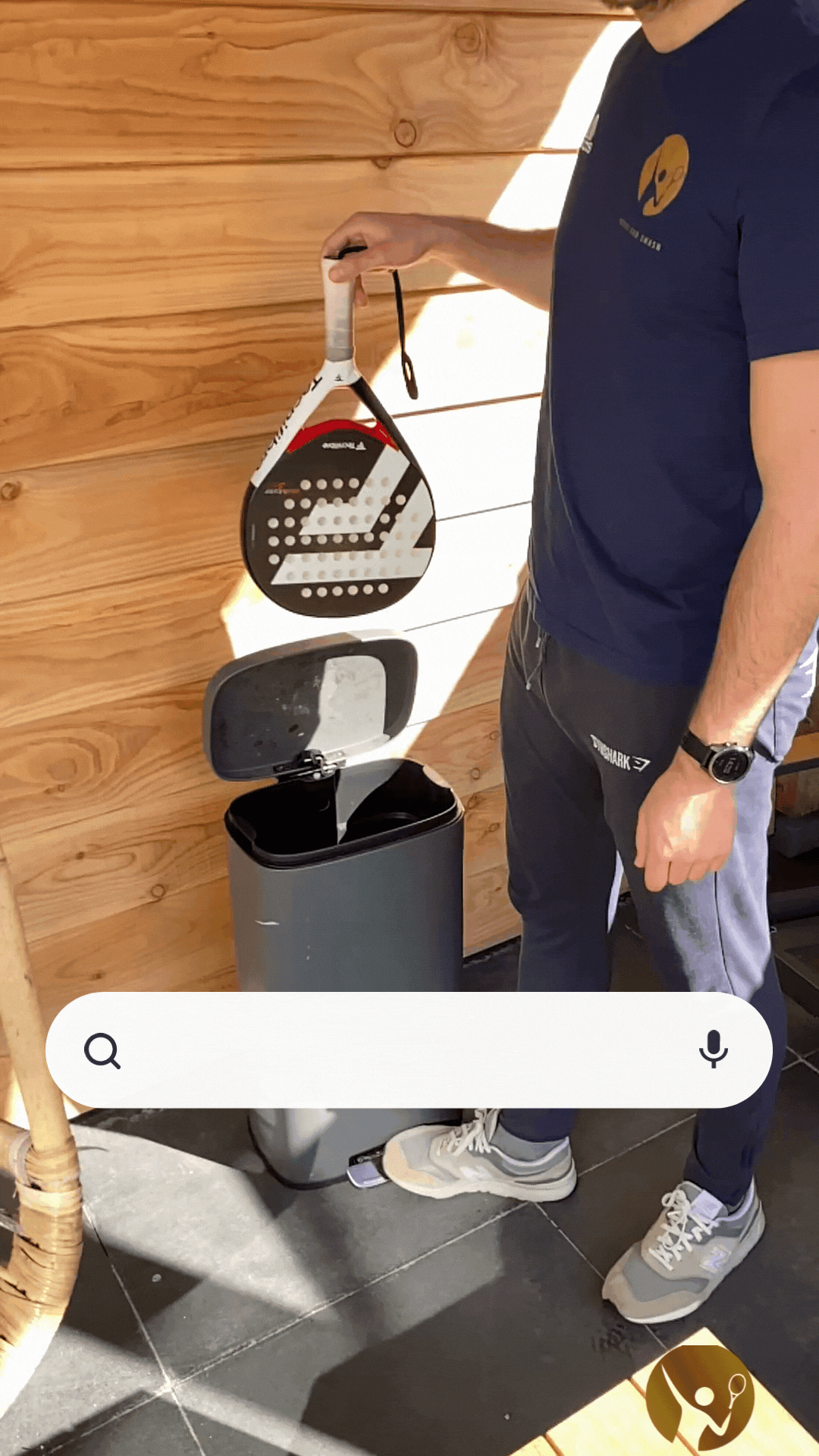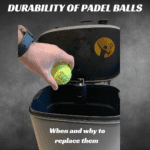This post may contain affiliate links.

The durability of a padel racket might not be on top of your mind at the time of the purchase. However, a padel racket can be quite an investment, so I would argue it is definitely a factor to consider. In this article, I will cover how long a padel racket should last as well as the factors that affect the lifespan.
Since your padel racket needs to be replaced at some point in time, I will also provide you with some visual cues to determine when it is time for a new one. Oh and when it is time to purchase your new racket, just remember the first point about durability!
How Long Should A Padel Racket Last?
Padel rackets typically last around a year, however, the lifespan is highly dependent on the following factors: material, usage, storage conditions, and environmental exposure. High-quality rackets that are optimally stored can last several years.
Materials
Another factor that determines the lifespan of your padel racket is the material. While it goes beyond the scope of this article to discuss all the parts that make up a padel racket, let’s focus on the ones that impact durability. The main differentiating parts in terms of durability are the material used for the racket face, racket frame, and core of the racket.
With regard to the racket face it is generally made of carbon fiber or fiberglass. Carbon fiber is more durable than fiberglass. Also within the realm of carbon fiber rackets, there are many subcategories, 3K, 6K, 9K, 12K, up to 24K at the time of writing.
Generally speaking, the higher this number the more durable the racket since it contains more carbon fiber strings (denominated in thousands). For example, 3K relates to 3,000 carbon fiber strings. As padel racket manufacturers continue to advance using these technological improvements, I anticipate that the number of carbon strings will continue to increase. If that is not the case, then they have found some other material to make the racket face more durable. Anyway, for manufacturers there will always be a balancing act between increased strength and durability versus the weight of the material.
What’s not to love about sponsored rackets?!
Most padel racket frames are also made of either fiberglass or carbon fiber. However, some rackets targeted at advanced and professional players, are made of kevlar. While this material is even more durable in terms of withstanding impact, it is also more expensive. Since the pros do want the best materials and need the additional power, the higher price tag is worth it. Not that they need to buy the rackets themselves of course. What’s not to love about sponsored rackets?!
The core of the racket is generally made of EVA rubber or foam. EVA rubber is harder and more durable compared to rackets with a foam core. As a result, cheaper and beginner rackets are usually made of foam. However, in order to make rackets for all types of players, there are also variants made of a softer EVA rubber core.
The difference in materials explains why beginner rackets need to be replaced earlier compared to high-quality padel rackets (targeted at professionals). But as you will see next, that is not all that there is to it.
Usage
Padel rackets are considered fragile objects, meaning they will not become more resilient as it is exposed to stressors. As a result, they will wear and tear as usage increases.
To put it simply, the more often you use your padel racket, the shorter its lifespan. Every time you hit the ball, the racket needs to absorb the impact of the ball against the racket blade. If this happens ‘enough’ times, then ‘at some point’, the racket needs to be replaced. But we’ll specify what ‘at some points’ means later when we discuss when to replace your padel racket.
Although rackets deteriorate over time as they are used, there is one caveat. That is the definition of the term ‘usage’.
While this general reasoning makes sense, it is likely that advanced players are also playing longer and more intense sessions but also play more frequently. Therefore I would argue that the durability of a padel racket should be measured in the number of played hours and should not be denominated as the number of months since its purchase or first use. The latter assumes that professional players and beginners play the same duration over the same time span, which is not very likely.
Storage Conditions
Another critical factor that impacts durability is related to storage conditions. In general, you want to store your padel rackets in a dry and ventilated environment at around room temperature for optimal preservation.
Let’s start with my favorite way of storing my racket before I go into why it is important to store your racket somewhere dry with sufficient airflow and at room temperature.
When I bring my racket(s) to the club, I store them in my padel backpack which has a separate cooling compartment for my racket. This compartment protects the racket against big swings in temperature. But we will talk more about the impact of temperature when we talk about environmental exposure.
However, many times I have too much other stuff such as my shoes, ball pressurizer, and recording setup with me. In that case, I do bring my larger racket back so I don’t have to worry about whether it all fits. You can conveniently get yours here .
.
While the racket face is able to withstand some water, it must not come as a surprise that a padel racket has holes in the racket face where water can slip through.
As discussed when we went over the material used for the core of the padel racket, the core of most beginner rackets is made of foam. While foam is softer it is also better at absorbing moisture and water. Although the moisture-absorbing quality of foam may sound like a benefit, it is actually not the case.
Let’s say the foam in your racket is fully absorbed with water, it weakens the core of the racket and it loses its cushioning effect. As a result, the ball has a greater impact (as if you would hit a heavier object) and the racket is more likely to tear. To prevent unnecessarily damaging your racket, you want to ensure that your racket can dry properly between sessions.
If this wasn’t enough reason to store your racket in a dry environment, let me give you another one. Mold, yeah you heard me correctly! If your racket is not in a dry and ventilated environment at room temperature, it cannot dry and you run the risk of mold growing in the holes of your racket.
If you care about the durability of your padel racket, I would suggest you do the same.
After all, mold loves humid dark places that lack airflow. This is why I want to be on the safe side and I make sure that I dry my racket with a towel before I put it back in my bag. If you care about the durability of your padel racket, I would suggest you do the same.
Note that rackets aimed at professionals are generally made of EVA rubber. Therefore they are less susceptible to absorbing moisture in the core. Nevertheless, you still want to store your rackets in the same condition for optimal durability.
Environmental Exposure
By now, you know that if your padel racket remains wet or is stored in humid conditions, it will definitely impact its durability. And again, if you played outside in the rain, make sure to follow the advice on storage conditions! But just before you decide to only play indoors from now on, let me reassure you.
You can definitely play padel in both warm and cold climates! Ultimately padel rackets are made to play in those conditions. However, there are definitely some factors to consider, especially since we are concerned about durability.
Heat makes your racket softer and therefore you need to hit harder with your racket than you would need in colder temperatures.
Fun fact : carbon fiber burns only at 399 °C / 750 °F in combination with a burning fuel source. While it is unlikely you will put your racket in these conditions, other components of the racket are going to burn sooner and your racket is still destroyed. Nevertheless, I would not advise you to try this at home.
As we’ve seen earlier when we talked about the core of the racket, you know the hardness of the racket is determined by the material used. But this is not the end of the story, since environmental exposure has its impact on the racket as well. If you play with a soft racket in the heat, your racket may become too soft to control the ball. Not to mention you have a hard time hitting the ball out of the court.
Cold on the other hand make your racket harder. That is why you run the risk of playing in an uncontrolled manner and make mistakes as a result. However, this might not be your greatest worry, since you would put additonal strain on your joints because there is less of a cushioning effect from the racket when you hit the ball. In terms of durability, harder racket may generate more power, but cheaper rackets may break more easily.
Humidity will not directly affect the durability of the racket unless you keep it in that condition for prolonged periods of time. The moisture as a result of the humid conditions can cause the core of the racket to be weakened. This is because the core will absorb the moisture and the racket becomes more fragile upon impact. Besides, the racket will lose some accuracy and responds differently.
When To Replace Your Padel Racket?
These visual cues tell you that you need to replace your padel racket:
- cracks between holes of the racket face
- crack on side of the racket frame
If this is not the case, it might not need an immediate replacement. However, if you see some structural damages appear it might mean that your racket is on the verge of breaking. Usually, you can still play some matches, but at that point, it is mainly a consideration between playing a couple of matches and the risk of playing with an unreliable racket. Worse than that, the unreliability of the racket can result in additional stress on the joints and even injury.
Or.. you do what the pros do and just buy two identical rackets!
Therefore if you have an important tournament or match coming up, I would suggest starting to use your new racket. This is mainly because you always need a couple of sessions to get accustomed to a new racket. Or.. you do what the pros do and just buy two identical rackets! In that case, you always have a spare racket of the exact same model as you are used to playing with. This will provide you with some peace of mind and not worry about getting accustomed to your new racket.
While picking up two rackets at the same time can be quite an investment, it makes it even more important that you pick a racket that suits your playing style and your requirements.
On a final note, manufacturers come out every year with a new model, which should be somewhat different. So even if you pick this year’s model, you might need some time to get used to it before you actually perform at your best.






